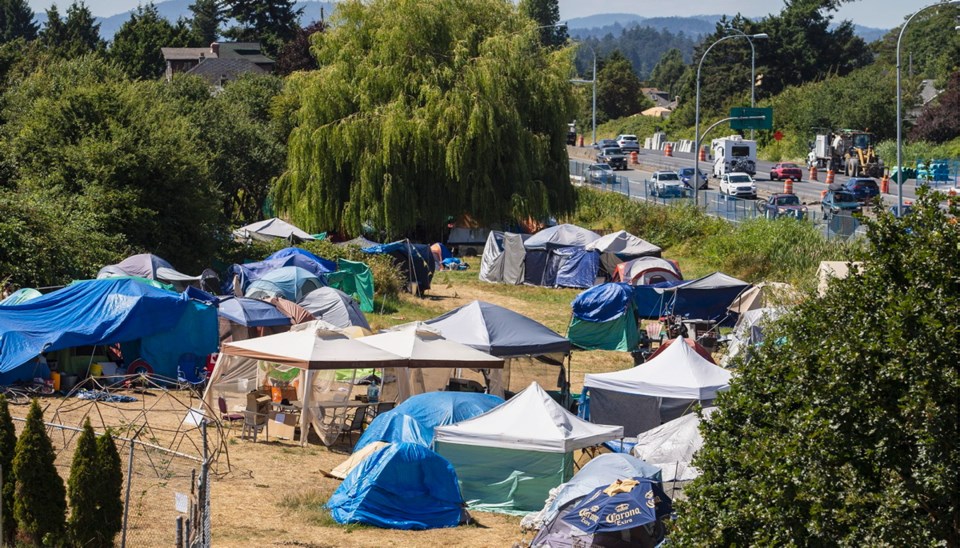I can relate to the people living near the Saanich and Nanaimo tent cities. Having lived by Victoria’s tent city two years ago, I know firsthand the dangers with some of the people who are occupying that land.
The recent arrests in Saanich of the tenters shoplifting from nearby businesses and threatening neighbours reminds me of my friends and neighbours in Victoria who were regularly threatened, even assaulted, had to deal with people defecating and urinating on their lawns, and had to deal with people shooting up and leaving their dangerous needles exposed. Anything in our neighbourhood not nailed down was stolen.
Now that we’re so close to municipal elections, politicians might take a knee-jerk response to quickly house these tenters with a model that houses too many people in too few buildings and endangers the neighbourhood. This leads to a model of “housing first” and “neighbourhoods second.”
The “housing first” model of giving someone a roof over their head goes a long way to helping people with so many problems. In addition to the personal benefits, there are many economic advantages, saving money in social services and health-care costs. But housing first must be done in a way that does not harm the hard-working, law-abiding, taxpaying neighbours.
On July 5, 2016, when Chief Justice Christopher Hinkson ordered the “campers” out, many people mistakenly believed it was because the province created housing for them. He wrote: “I do not propose to decide this application on the basis of housing options that the province proposes to provide to residents of the encampment, some of which are not yet available. In determining whether the encampment should be allowed to continue until the scheduled trial, I will consider whether conditions at the encampment and in the surrounding area have significantly deteriorated.”
Despite arguments from the lawyers supporting the tenters, Hinkson wrote: “The encampment is unsafe for those living there and for the neighbouring residents and businesses, and cannot be permitted to continue.”
Instead of the province creating housing options with a reasonable number of people in each facility, it took the cheapest route possible by housing too many people in too few facilities. And clearly it hasn’t provided enough support for those with addictions and mental-health problems. Ask the neighbours, residents and businesses, living in proximity to the Johnson Street, Ellice Street or Douglas Street facilities.
I recently spoke to a Victoria first responder who painted a picture of these facilities that is right out of a movie. To slow down police getting to the proper floors, the elevator buttons are burned off. If fire doors aren’t blocked by bikes and shopping carts, they’re propped open, allowing drug dealers, prostitutes and johns to come and go freely. In one of the facilities, this first responder said, you wouldn’t want to go into this place, let alone touch anything. But don’t take this person’s word for it: Just read the arbitrator’s ruling regarding “guest passes.” It’s bleak.
As taxpayers, we’ve been sold a bill of goods when our provincial and municipal elected officials say “once people are housed, things will settle down.” They should, but not with the model of too many people in one building. So don’t blame the neighbours when they push back against these empty promises, as they’ve seen the exact opposite in the news.
On July 6, a front-page article in the Times Colonist noted that neighbours reacted with “horror” at the thought of the former Emily Carr library being turned into social housing for the homeless. They are not heartless people; they are realists who have seen these knee-jerk reactions create nothing but trouble, while the politicians and bureaucrats pat themselves on the back, telling us what a wonderful job they’ve done.
There are solutions to these problems, even for municipalities that have a limited jurisdiction in this area.
1. Support housing of people in numbers that are reasonable and that don’t cause constant problems for residents and businesses.
2. Don’t rubber-stamp the province’s request for facilities that are too large.
3. If the province insists on this unworkable model, then there must be enough support for those inside, along with real and enforceable security for neighbours outside.
4. If the province thumbs its nose at the safety and security of our neighbours, municipalities must step up with more money to give the protections law-abiding citizens require.
5. To pay for these extra services, municipalities can reduce the tax exemption these provincial-funded agencies receive by the same amount. For example, Victoria residents subsidize the province of B.C. by giving tax breaks for these provincially funded programs and buildings.
Our provincial government puts extra money into projects it supports — such as the new project labour agreement. Protecting neighbourhoods while they figure out better ways to support the most vulnerable should also be something they can support. And our civic governments should accept nothing less.
We can support housing in workable numbers for the most vulnerable, but it can’t be at the expense of the law-abiding, taxpaying neighbours. Housing first can’t mean neighbourhoods second.
Stephen Hammond lives in Victoria. He was one of the founders of Mad As Hell, a neighbourhood group that mobilized when a tent city was set up on the courthouse lawn.



